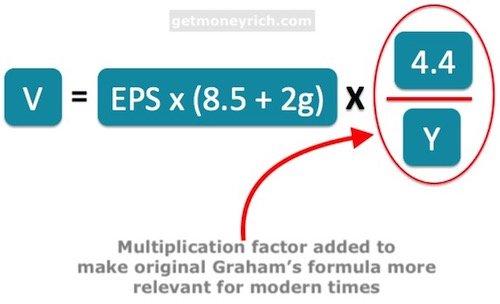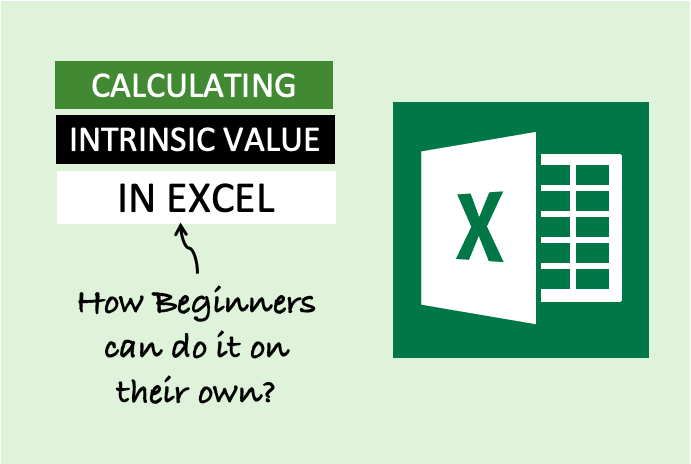The intrinsic value formula can help one estimate the ‘fair value’ of stocks. But why bother about ‘intrinsic value’? Why not simply buy stocks at an available market price?
Because stocks will be profitable only if one buys them at a price below their intrinsic value. In fact, Benjamin Graham (The Guru to Warren Buffett) says that stocks must be bought at a ‘discount’ to their intrinsic value.
What does it mean by discount? Suppose a stock’s market price is Rs.100. Upon estimation, its intrinsic value comes out to be Rs.90. In a couple of months, the market price of this stock fell from Rs.100 to Rs.80.
At this price level, the stock is said to be trading at a discount of 11.1% to its intrinsic value [(90-80)/90].
Intrinsic Value Calculator (Ben Graham’s Formula)
| Data Input | |
|---|---|
| Current Market Price (Rs.) | |
| Current Year EPS (Rs.) | |
| Expected Growth Rate (%) in the next 5 Years | |
| 10 Year Indian Government Bond Yield (%) |
| Answer | ||||
|---|---|---|---|---|
|
Market Price

The market price is the current price of a stock at which one can buy and sell it. There is no partiality here. Even Warren Buffett has to buy stocks in the stock market at their’ market price’, like us.
But the difference between Buffett and us is in the awareness of intrinsic value. Warren Buffett will never buy a stock without knowing its intrinsic value. Why? Because he buys only those stocks that are available at a discount to their intrinsic value [Market Price less than Intrinsic Value].
Intrinsic Value (Undervalued Stocks)

Warren Buffett aims to buy stocks at a price below its intrinsic value. Such stocks are called undervalued. What is the utility of undervalued stocks? The price of such stocks has a stronger tendency to move up over time.
There can be two stages of price moving up:
- Leveling with Intrinsic Value: The first stage will be when the market recognizes that the current stock price is undervalued. In this case, there will be more buyers for this stock than its sellers. Hence its price will start moving up. This upward price momentum will continue till the market price equals the intrinsic value. Read more about the concept of intrinsic value of stocks.
- Move towards overvaluation: The price of undervalued stocks will rise till they level with their intrinsic value. This is like a certain logical growth. But often the forward momentum takes the price beyond the intrinsic value levels. This is where the stock starts to become overvalued. Read more about how to identify undervalued stocks.
For potential investors, the target should be to identify an undervalued stock, and buy it at a ‘discount’. Such stocks have greater potential to give delta returns as highlighted in the above infographics.
Intrinsic Value Formula
There is a book on value investing called “The Intelligent Investor“. This book is written by Benjamin Graham (The Guru to Warren Buffett). In this book, he has mentioned a formula. This formula can be used to estimate intrinsic value.

The formula looks like this:
V = EPS x (8.5 + 2g) – (i)
- V = Intrinsic Value.
- EPS = Earning Per Share.
- 8.5 = Assumed fair P/E ratio of Stock.
- g = Assumed future growth rate (7-10 years).
In the year 1962, Benjamin Graham updated the above formula to make it more flexible for future use. He inserted a ‘multiplying factor’ in the original formula. He called the multiplying factor as interest rate factor. After this small tweak, the updated formula looks like this:

- 4.4 = Interest Rate of AAA Corporate Bonds in USA in the Year 1962.
- Y = Interest Rate of AAA Corporate Bonds in USA as of today.
Ben Graham’s Formula Updated for India
The above formula has many limitations. Experts of fundamental analysis of stocks prefer going into more detailed calculations to estimate intrinsic value. Read more about doing detailed stock analysis in MS Excel.
In the above formula of Benjamin Graham, there is a factor of “4.4”. This makes it suitable for stocks trading only in the US. There must be a different factor for Indian stocks, right? Why?
Because in the denominator there is a factor of “Y”. What is Y? Interest rate of AAA corporate bonds operating in a country (for us it is India). Hence, the numerator must also be tweaked for India.
Hence, I thought to use a slightly different form of this formula for my stock analysis. But the problem was, nowhere I could find the yield of AAA Corporate bonds of India in 1962. So I thought to use the below assumption to reconfigure the multiplying factor:

Hence the revised Benjamin Graham’s intrinsic value formula looks like this:

[Intrinsic value calculator based on Benjamin Graham’s Formula]
Conclusion
Benjamin Graham’s intrinsic value formula is only a starting point for stock valuation. It can only give a rough idea of the intrinsic value of the stock. But one must not base their decision on this formula alone.
It is better to cross-check the true value of stocks by using more detailed tools of fundamental analysis. I personally use my stock analysis worksheet to do a more detailed analysis of my stocks.
Handpicked Articles:





This is a great calculator! I’ve been trying to figure out what my intrinsic value is for a while now and this is a great tool to help.
Till date I tried my best to find out intrisic value formula. today I got it , thank you VERY MUCH “MONEY MANI”. I am renewing my money knowledge( share market) in your website daily in details.
Hi Mani,
I am beginner, knowing nothing much about trading of stock but try to get information from various sources, to buy the stock and keeping lot of enthusiasm. Well after reading your blog on intrinsic value, open eyes. It’s really great information.
Thanks.
Respected sir I have a doubt about corporate bond when we buying shares
Why we need to put the value of India AAA bond yield we are going to buy a company share if we take ROE percent its also come one result pls give me some idea
its really worth exploring this website with lot of useful financial information,kudos to the author
Thanks for posting your appreciation.
There are no confusion after reading this. Thanks a lot
Hi Mani
While surfing the net for “How to invest in stocks(NEVER invested in stocks before n no knowledge) ” i came across ur blog n worksheet, which i am about to buy.
Plz clarify few points:
1. Does ur worksheet works for penny stocks, for investing for 5-10yrs.If the company is relatively new, wut % should i fill in future prospects, as i cant evaluate the company`s financial data to give it a growth %
2. Will ur worksheet work, if the historical data is less than 10 yrs.
3. Does the values we enter needs to b changed frequently,lets says i monitor a stock for 1 month. Do i have to change any values after a certain period like 5,10,25 days to get the correct intrinsic value.
An early reply will b appreciated.
THANKS
Worksheet needs 10 years data. It will not work without it. If the user wanter, they can update the data every quarter (quarterly statement, and price datae), though it will change the intrinsic value a lot because it derived more from the historical 10 years data. Hence it is more stable and give it its relative reliability. Thanks for the query.
Hi, Can you give an example of a stock with the above formula? When I am comparing my answer with your online intrinsic calculator it is different all the time. Foe example take Hindustan Zinc with share price of Rs. 192.55, eps= 17.7, g =9, Y=6.08, so V= EPS x (8.5+2g)x8.5/Y = 17.7x(8.5+(2×9))x8.5/6.08 = 655.74rs but your online calculator shows rs214.79. Can you advise where am I going wrong?
“g” shall not be taken as 9, it is 9% (0.09). Thanks for your comment.
ur p/e is of 8.5 while sensex avg p/e is 22 over the years
pls update
It is a standard formula developed by Benjamin Graham who used the “factor of 8.5”. I think it cannot be changed. The multiplication factor added beside the main formula should take care of other variables.
i didnt get you
can you give some idea
I was looking for a different calculator for calculating the intrinsic value of stocks and came across this blog. I personally think that the best estimate is obtained if discounted cash flows are used. Each company is different and it is difficult for one formula and only one set of assumptions to be good for all companies.
Hello
please help me to calculate graham number of the company. i am a research scholar. i want to see it for pre and post period graham analysis. it is a growth stock
Sure, It ‘ll be a nice exercise.
Excellent article for finding out intrinsic value of a stock
Thanks for the applause
That’s a very useful information.Thank you and Keep sharing about Value Investing ideas.
hi,
you provided the great formula to identify and make the finance decision. very nice presentation.
Hi Mani,
Goof article. Challenge is how to find the future growth of the compnay. Do you have any advice on how to estimate this figure (g)?
Thanks.
Future growth rate can be estimated by seeing the past trends. Sometimes, company’s also share their future forecasts. But I agree, it is a challenge
Thanks.content was very good.I was wondering from last one year to learn how to calculate intrinsic value of the stock.
Hi Mani,
Thanks for such wonderful information. I tried using teh formula however it is difficult to find undervalued stocks. Most of the top performing stocks are overpriced.
Regards,
Deepak P
You are right. At a point in time where Sensex is close to 40,000 points, this is what is expected. You can see my watchlist, may be you can find some undervalued ones there.
HI, you wrote : 1962 in India, AAA Corporate bonds must have been yielding 7.9% per annum. Is this your assumption, or did you take it from a source?
I have made a guess. I have gives its rational in “Limitation of Graham’s Formula”. Thanks for asking.
First of all thank you for this wonderful post for helping to make understand the intricacies of intrinsic value. I am completely new to investment and my curiosity led me to this page when I googled for it. As you have said, this is deep knowledge and maybe I have grasped it superficially but then atleast there has been a start for me. I just wanted to ask, if we follow the concept the intrinsic value, should WE ALWAYS resist from overpriced stock even if they good stocks? Because depending on the times, most of the good stocks will be most likely overpriced at current time and should I be patient to wait for its prices to drop down (Should we really wait even if its very long) ?
Purchase of overpriced stocks are never advisable, no matter how big is the brand name. Thanks for asking.
Very good and informative site on stock markets. Thanks for sharing lot of tips and advices.
Ajanta Pharma Example- Last 5 year EPS has come down to 48.6 from 62.8 ie 23 % negative growth. Which growth rate is to be assumed ? and what will be intrinsic value as per your excel sheet ?
Future growth rate assumption cannot be made by only looking at EPS. One has to see the other growth metrics to arrive at an assumption. Thanks.
How did you calculate expected Growth Rate (%) in next 5 Years in http://ourwealthinsights.com/calculators/iv-ben-graham-formula.html?
Is there any formula or any website which directly gives this value?
This should be an estimation for each stock. How to estimate? See last five years sales growth, profit growth, EPS growth, Net worth growth etc. This gives a fair idea. Thanks for asking.
Very informative. Keep up the good work. God bless.
very powerful, useful, beautiful information
Is assuming 8.5 as the PE in the formula also suffering from the same problem as 4.4% interest rate factor for AAA rated corporate bonds in 1962 – pertaining to a period of time and not dynamic to suit the present times ? Maybe the reference may need to be made to Industry PE in the past 3/5 years or so ? In this case, multiple of 2X Growth Rate is also called to question, making the formula more subjective.
VALUE CREATION=ROCE-WACC÷ROCE is not reflected in your sheet.
how to calculate assumed growth rate(g) of stock?
Roughly it can be estimated by looking at pat 10 year growth rates of the following stock metrics:
– Sales.
– EPS.
– Free Cash flow
– Net Worth.
– Asset.
Where this cagr for calculating intrinsinh value is given in results?
Dear sir,
Probably a basic question from a beginner. when is it recommended to sell the stock?
Should we sell the stock when market price rise above calculated intrinsic value or value investors should hold forever? when to realize profit?
It is a tough question. The answer can get complicated.
But I follow this rule, which is simpler:
“Before purchase, fix a target price (with respect to the intrinsic value). Once the stock price breach the target price, sell. Make sure to reinvest all money back into a value stock”.
In your stock analysis worksheet you are calculating intrinsic value by different methods. That’s fine. But what is the basis for you arrivng an intrinsic value by averaging the values of all the methods. If you just take only 2 or 3 methods the average will be different and hence intrinsic value too. Please justify.
The estimated intrinsic value is not average.
It is better to consider weighted average when dealing with intrinsic value.